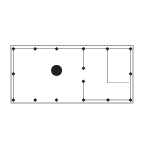Nomadic Bodies
Preamble
Vehicles are strange homes; nomadic bodies filled with trappings of domesticity. Inhabited repeatedly and incessantly, these unattached parcels form liquid sociologies. Day after day, cities pass each other at 30 frames per second. They briefly illuminate one another. A litany of lighted apertures becomes an exquisite and incomprehensible film, revealing clues of a secret ecology. Riders embark, and a city is conjured, then disembark, folding and packing homes into their pockets and bags.
Summary
There is a telling scene in The Darjeeling Limited (2007) where the train is represented (filmed) in section perspective, depicting a multitude of characters with the artifacts of their emotional and domestic imaginaries. Using the technique of the section and the form of the train, Wes Anderson is able to skillfully jump from imaginary to imaginary, putting in close proximity, the strange domesticities of many emotional trajectories. This powerful strategy is not unlike how Rem Koolhaas imagines the elevator (or the grid) operating in New York City.
Transit infrastructure operates one scale smaller than the grid, at the scale of the sign or the typeface and one scale larger, the scale of a region (jump cuts operating at the territorial scale). The speed (speed of occupation/turnover) of transit infrastructure is imagined to be much faster (more expedient, in flux) than the speed of occupation of a typical tower (with contingencies, and relational forms changing from station to station). In effect, fleshing out intermediate and territorial scales and speeds of infrastructural habitation explicates the measure of urbanity as a matter of collective inertia (people in motion, flows) rather than density.
Program: Commercial/Transit
Location: Japan (Osaka, Kyoto, Nagoya, Yokohama, Tokyo)
Year: 2017
Copyright © 2018 Evio Isaac
